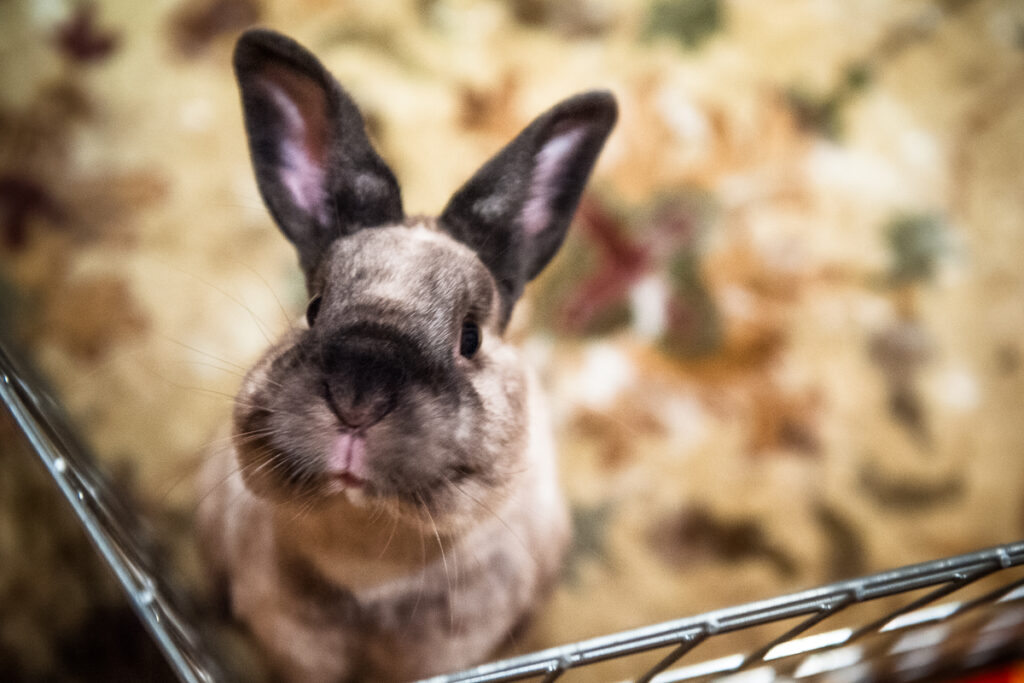RABBITS ARE COMPRISED of paradoxes that make them highly entertaining—inquisitive yet cautious, skittish yet confident, energetic yet lazy, timid yet bold.
They are crepuscular, meaning most active at dawn and twilight. They spend a long mid-day “down time,” during which many will seek a quiet corner inside their pen or under a chair for a nap. This habit fits the schedule of working people who are away from home part of the day. Bunny may be just waking up when you arrive home and will be delighted to see what treats you bring.
Living low to the ground ( floor, carpet), they are clumsy in high places. Yet, their explorations may take them from inside the closet, behind the sofa, or under the bed to the heights of dressers, desktops, and tables. A single youthful rabbit can lay waste to the contents of accessible shelves, delighting in pulp fiction and the daily news. And the clatter heard from the kitchen is most likely due to pots and pans being rearranged.
Witty and Willy
Rabbits solve problems, like pushing on doors that open outward and pulling with their teeth on doors that open inward. They learn to use a litterbox, to come when they’re called, and to sit up and beg for a treat. They have a remarkable ability to remember furniture arrangements and where the snacks are kept.
They can learn procedures and routines at any age. Smart animals that they are, rabbits play games—with toys, with other animals, and with their humans. They play games of their own invention, punctuated by sudden vertical leaps and /01° turns in mid-air.
Consistent with those of other animals, rabbits’ games mimic survival techniques. Just as predatory animals enjoy chase games, rabbits more often play getaway games. Sometimes carrying a prized possession (such as a cracker), one may run from imagined thieves. Or after yanking an envelope from a human hand, a frisky rabbit zigzags off with a “catch-me-if-you-can” dare to pursuers. And on many occasions, witnesses have observed rabbits playing follow-the-leader.
“Rabbits who live in our houses adapt to our schedules…”
Freedom to Perform
Similar to other animals when allowed some freedom. rabbits perform beyond their supposed capacity. The key here is opportunity in a stimulating interactive environment. What individual expression can you expect from an animal who never gets out of a cage? A rabbit in a backyard hutch will be unable to do more than just sit there.
Ages and Stages
Like kittens and puppies, rabbits can be a handful when they are young. Most rabbits will mellow out at maturity. The stage of intense curiosity, hyperactivity, and frantic chewing and digging occurs at the height of adolescence (4-8 months) -a time that recommends neutering or spaying. Bunny-proofing efforts should be heightened at this time, and plenty of litterboxes should be available in all bunny areas.
Some of the rabbits we rescued years ago were never adopted into new homes and have continued to live with us. As they settled in, they became easier to manage and very mellow. All are spayed or neutered. Our seniors (over eight years) move about a little slower and sleep a lot more and graciously accept friendship in their golden years.
Effects of Shared Occupancy
Rabbits who live in our houses adapt to our schedules and take up our habits. Like us, they are preoccupied with appearances and have fastidious grooming habits. They engage in household activities with other occupants. They learn many human words and can distinguish their names, as well as “Come” “Box” “Outside” “Yum” “Let’s go”, and several endearing terms and sentimental sweet-talk delivered in the right tone of voice.
©Copyright Marinell Harriman. All Rights Reserved. Republished with the permission of the author.
Mental Makeup was originally published in House Rabbit Handbook (5th ed.).

